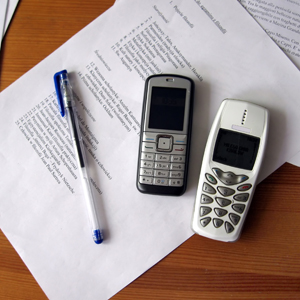The importance of following up, touching base and otherwise staying on the mind of the client shouldn’t be underestimated. I’ve seen it in action. Diligent follow up has helped me win business (as told later on by clients), and I have given business to providers who followed up with me in a consistent and palatable way. Following up tells the potential client that you want the work, you think you’re the best person for the job, and you’re ready to get started. All powerful factors that can nudge an opportunity in your favor. But the line between an acceptable follow-up technique and “you are so annoying, please stop contacting me” is very thin. If you cross it, you will likely lose the opportunity and close the door on any future opportunities that may exist. How do you tell how much follow up is too much? Here are a few follow-up rules to keep in mind.
 Set a Schedule
Set a Schedule
You should have a predetermined schedule for following up with prospects, depending on the desirability of the work, with the most desirable clients requiring the bulk of your follow-up time.
Making a follow-up schedule ahead of time serves two purposes. First, it makes the entire follow-up process quicker, especially if you’re able to use partially pre-written or automated messages. And second, setting a schedule before you’re in a follow-up situation can reassure you that the message intervals you’ve decided upon are typical and not the overly aggressive reaction of someone who really wants the work but hasn’t heard back yet.
Start with the Client’s Communication Preference
There isn’t a defined rule on the best way to follow up, but it’s a very good idea to follow the lead of the person you’re following up with. If he or she prefers email and most of your conversations have taken place over email, it probably makes sense that your initial messages will be sent via email. This doesn’t mean you’re restricted to email-only communication, though. Sometimes adding a new method to the mix can initiate a new (hopefully favorable!) response.Learn to Read Between the Lines
Even the most diligent follow up isn’t always effective in getting you the answer you want, or any answer at all, for that matter. You need to be able to read the situation and understand that what isn’t said can be just as important as what the client says. For example, repeated lack of response probably means the client is not interested and it’s not worth your time to continue following up. And a statement like, “We’ll be in touch soon,” may mean it’s time to back off a bit and slow down your follow-up messages.Make Your Follow-Up Message About the Client
Your follow-up messages shouldn’t just be repeated sales pitches. Craft your messages so you refer to any personal information that was exchanged during meeting, unique elements of your conversation or things you learned about the client’s specific needs. You can also follow up in a more relaxed way by sending the client a link to an article relevant to their situation or other information that will keep you on his or her mind without you having to say, “I’m following up again…”Don’t Follow Up If You’re Not Genuinely Interested
Because the follow-up process is something that is generally structured and repeated, it can become a habit that you tend to do automatically. There may be nothing worse, though, than following up over the course of a few weeks or months, being offered the opportunity, then deciding you don’t want it after all. Before you even begin your follow-up routine, make sure it’s something you are sure you want to protect everyone’s time. The trick with following up is trying to figure out what is most effective in each situation because it can be different every time. Ideally, you’ll be able to develop a schedule and a set of messages that work well over time, then tweak and customize them for each individual situation. What are your secrets to effectively following up with potential clients without being annoying? Image credit: bury-osiolFrequently Asked Questions (FAQs) about Following Up
What is the best way to follow up without being annoying?
The key to following up without being annoying is to be respectful and considerate of the other person’s time. Always ensure that your follow-up is necessary and relevant. Be concise and to the point, and avoid sending multiple follow-ups in a short period of time. It’s also important to be patient and give the other person a reasonable amount of time to respond before you follow up.
How long should I wait before following up?
The appropriate waiting time before following up can vary depending on the situation. However, a general rule of thumb is to wait at least a week before sending a follow-up. This gives the other person enough time to respond to your initial communication.
How can I make my follow-up more effective?
To make your follow-up more effective, ensure that your message is clear and concise. Be specific about what you’re following up on and what you’re hoping to achieve. It’s also helpful to include a call to action, such as asking for a response by a certain date.
What should I avoid when following up?
When following up, avoid being overly aggressive or pushy. It’s also important to avoid sending too many follow-ups in a short period of time, as this can come across as desperate or annoying.
How can I follow up on an important or urgent email?
When following up on an important or urgent email, it’s important to convey the urgency of your message without being pushy. Be clear and concise, and explain why the matter is urgent. It’s also helpful to provide a specific deadline for a response.
How can I follow up in a professional manner?
Following up in a professional manner involves being respectful, considerate, and understanding of the other person’s time. Always ensure that your follow-up is necessary, relevant, and concise. It’s also important to use a professional tone and language.
Can I use a follow-up email template?
Yes, using a follow-up email template can save you time and ensure that your message is clear and professional. However, it’s important to personalize the template to fit your specific situation and the person you’re communicating with.
How can I follow up after a job interview?
After a job interview, it’s appropriate to send a follow-up email or note thanking the interviewer for their time and expressing your continued interest in the position. Wait at least a day after the interview before sending your follow-up.
What should I do if I don’t receive a response after following up?
If you don’t receive a response after following up, it’s appropriate to send another follow-up after a reasonable amount of time has passed. However, if you still don’t receive a response after multiple follow-ups, it may be best to move on.
How can I improve my follow-up skills?
Improving your follow-up skills involves practicing effective communication, patience, and professionalism. It’s also helpful to seek feedback and learn from each experience. Remember, effective follow-up is about respect and consideration for the other person’s time and needs.
Alyssa Gregory is a digital and content marketer, small business consultant, and the founder of the Small Business Bonfire — a social, educational and collaborative community for entrepreneurs.

